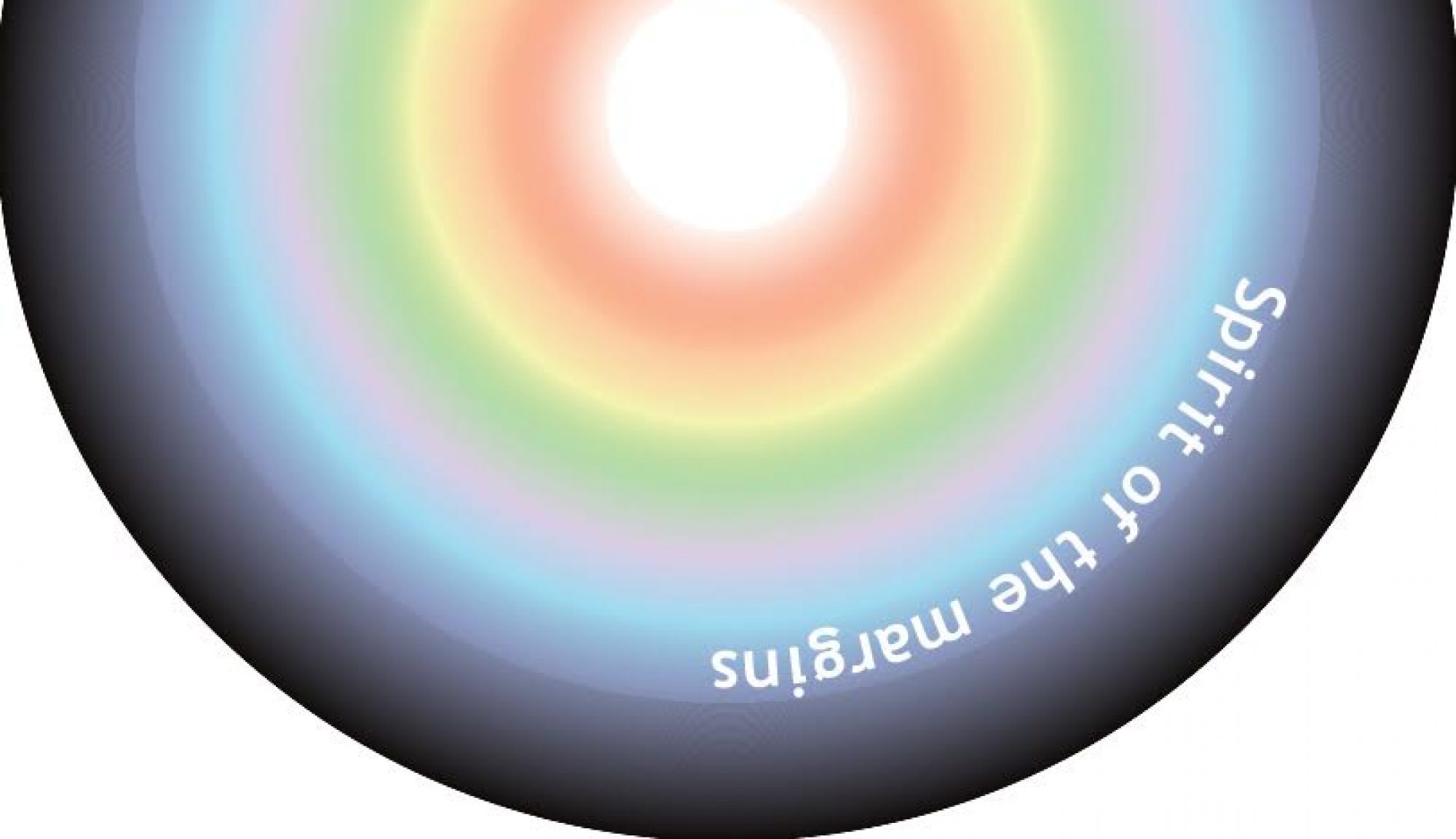1. Bognor Regis
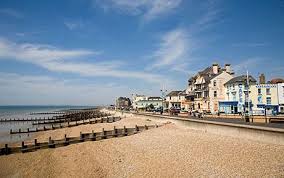
Several towns might compete for the title of the most marginal town in Britain, but my vote would be for Bognor Regis. I live there so it’s OK for me to nominate it.
When I first arrived, back in 2000, I thought I would stay for just two or three years, but here I still am 19 years later. I remember being told it was a town of low self-esteem: no one chose to come and live here unless they really had to. More often than not, that ‘had-to’ was because of lower property prices than the surrounding areas. As a result, Bognor attracted a higher proportion of people – the elderly, people with disabilities or difficult social situations – than other neighbouring towns.
That was not the original idea. When Sir Richard Hotham started to build Bognor Regis (or Hothampton as he wanted to call it) the plan was to build an up-market resort which would syphon off the great and the good from Brighton. Sir Billy Butlin succeeded where Sir Richard failed, creating a more down-market venture which attracts over 385,000 people every year.
Currently, it has one of the highest rates of immigration in the South East, with people from throughout Europe keeping the farms, the care homes, the hospitals and much else going.
Bognor is geographically marginal too. It’s next to the sea, so there’s no further for the trains to go. I remember once being astonished to see a friend from London – now long since deceased – walking along a street in Bognor. I stopped my car and ran to see if she was really the person I thought she was. She had clearly been struggling with the stresses and strains of life in the capital. ‘I just decided I had to get out, and this was as far as the first train I could get would go’ she said. Perhaps that accounts for how many people arrive in Bognor.
So what keeps me in Bognor Regis? Partially it’s the sea – see number six below. But perhaps it is more that I appreciate the social mix here more than the more up-market and heterogeneous towns in the vicinity. A someone told me early on, ‘Bognor is authentic’: people are not trying to hide behind masks and keep up appearances. So, let’s nominate Bognor as the Marginal Capital of Great Britain.
2. The edge of a potato field
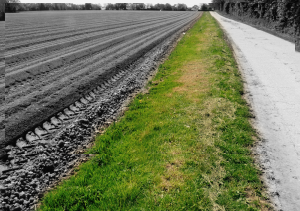
I was cycling along a path next to a field when I became aware of the space – the margin – between the field and the path. The path was used by people – like me – going to and from a nearby Farm shop and nursery. The field was being prepared to grow potatoes. In between was a strip of land to which I imagined no-one ever paid much attention.
I saw this as a metaphor for much of life. The potato field was the world of growth and productivity, efficiency and effectiveness; a mono-cultural place where weeds are ruthlessly eviscerated. The focus is on how much can be grown and how quickly. The path was the world of busyness and movement: people moving from A to B and then back to A – or onto C. In between these two worlds was a marginal world that was not usually noticed either by the growers or the travellers.
Having recently stopped full time work, I could identify with that world. I began to see it as place that is in-between – when we are no longer totally fixated on going places or doing more and more; a place which is easily overlooked, but which is, potentially at least, a place for a diversity of plants and the insects and wildlife that are drawn to them; a place that is more about being than doing. The Sundarbans
3. The Sundarbans

I could have chosen any number of other places to indicate places that are under-threat from global warming and environmental degradation. The Arctic and Antarctic, the Amazonian Rainforest, numerous Islands and coral reefs to name just a few. Instead, I’ve chosen the Sundarbans.
The Sundarbans (“Beautiful Forest’ in Bengali) are a land of tigers, crocodiles, snakes and cyclones, situated in the Bay of Bengal. Created by the confluence of the Ganges, Meghna and Brahmaputra rivers – the largest delta in the world – roughly 40% of the Sandarbans are in India and 60% in Bangladesh.
The Sundarbans are marginal in many respects. During the monsoon period all the Delta is submerged, much of it for half a year. Rising sea levels have diminished the surface area of the Sundarbans by two thirds in recent years; they have also resulted in increasing salinity. Increasingly brackish river water from Bengal has encouraged the tigers to eat humans more and more: the sweetness of human blood helps them obtain a better dietary balance.
The population of the Sundarbans is around 4 million, mostly living on agriculture (especially deep-water or floating rice) and fishing (shrimps). However, with the threat of snakes, crocodiles and tigers, living is precarious both physically and economically.
(From: Forest of Tigers: People, Politics & Environment in the Sundarbans by Annu Jalais)
4. Dream Island

‘Last night I was transported to a thin bar of sand in the middle of the ocean. The sand could only just be seen above the surface of the water; different currents pushed from east and west. A woman was driving the motorboat which left from a city in the East. Once on this margin of land I would be dropped off and face the unknown. The chance of another boat passing by and taking me onto the adventurous west. Or would I seek to return back with the woman in the same boat to the east – to the old familiar places I had just left? This margin of land represented decisions: how small, often marginal, changes can make all the difference.’
5. The space between tectonic plates
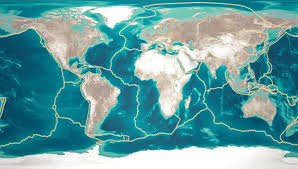
The outer crust of the Earth is composed of 12 major tectonic plates which float on and travel independently of each other over the Earth’s mantle.
Earthquakes are caused by faults between the Earth’s tectonic plates. Faults in the lower layer of the Earth – below 10 – 15 miles deep – can be accommodated quite easily. The temperature is high, and the rocks can be deformed without breaking: they are pliable, not brittle. They flow.
In the outer layers of the Earth – the top 10 – 15 miles – however the temperature is low and cold, and the plates are much more rigid. Weakness – deformities – cannot be easily expressed. As a result, the rocks are much more resistant, much more rigid, and they react strongly when they reach the limit of resistance: there is a major commotion and there is an earthquake.
In one case, the faults are mediated by weakness – the hot, softer material between the plates. In the other, the rocks are much more rigid and bang up against each other.
It’s often the same thing in society. Societies which put a great emphasis on being very strong and rigid do not take into account the weak points of society, the people who are struggling or suffering, tend to be societies that do not evolve. If and when they do move, it’s generally by an earthquake, a revolution in other words. By contrast, Societies that incorporate fragility are much more likely to change and evolve more progressively and smoothly.
(Adapted from Aux racines de l’homme: De la mort à l’amour (To the roots of mankind: from death to love) by Xavier le Pichon
6. Floating on water

It’s next to the sea, and, particularly when I first arrived, I loved floating on the water – treasuring that feeling of being on a liminal space between sea and air. Feeling trivial – marginal – in relation to the immensity of the oceans and yet also strangely special and significant, a cognisant body in the enormous reaches of the Universe. From there I felt a deep sense of connection to the world, imagining how the waters supporting me are connected to other waters which ultimately surrounded the whole world; and how the water currently under me has, in times past, supported boats, people and fishes in places as far afield as the Pacific and Indian Oceans.
7. Sitting room in the Street
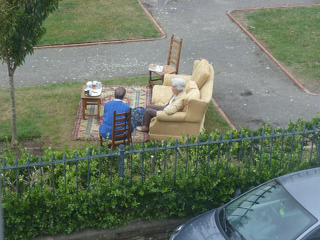

A couple of times last year I took my sitting room – including sofa, chairs, carpet, bookcase, standard lamp and coffee table – into the public gardens outside my house. I offered a cup of tea to anyone who showed any interest in what I was doing.
It was based on a piece called ‘Encounter’ which a friend of mine, Jon Bowra, had developed on a street in Oxford as part of his MA in Social Sculpture.
An English person’s home is said to be their castle – a place where we feel secure, protected and private. So I loved the idea of taking it into a public space. Once there, I enjoyed looking up at my new ceiling: bright blue sky with moving clouds and no cobwebs in sight. Straight ahead I could just make out the waves breaking onto the shore. But what I enjoyed most was waiting to see who came past.
At home, I know everyone who enters. But out there – in the margins – it was open to anyone who passed by. I noted that some people were intrigued but uncertain – they liked to keep their distance. Perhaps, over time, that would change. But what I loved most of all was the people who came up and engaged. The conversations, the laughter, the getting to know one another.
Much as I loved doing it, it also required some courage to take up residence outside. A homeless man had set up a tent nearby some weeks previously, and had not been universally welcomed. Would I be seen in a similar light? As often happens, in going into the margins, there was an element of being willing to be vulnerable.
8. The Hospice

The journey of death is taken by each of us alone. There is a sense of vulnerability: none of us knows for sure what will happen on the other side, even if our faith (or lack of it) may seek to convince us otherwise. Dust to dust is the ultimate form of transformation – moving our relationships with others into another dimension.
The hospice reminds me of the times I have shared with people just before and after they have died, when I sense the thin curtain that separates this life from whatever follows. It can feel initially awkward – we are not used to being next to dead bodies – but if I allow myself to overcome the initial fear, it can be a beautiful, peaceful, unique, transforming moment.
Living as part of L’Arche in France, the bedroom of the dead person would become a shrine for a day or two, with objects associated with the person decorating the room. Friends and relatives would often spend hours with the dead person, saying their goodbyes and savouring their presence or mourning their absence.
I found this almost impossible to do in the UK. Even in the local hospice, I learned the other day, we do not have the refrigeration equipment – essentially a cold surface – to keep the body in the room for more than 12 hours or so.
Perhaps, as with so many margins, we need to bring death more into the centre of our lives.
9. The Artists’ studio (or the writer or composer’s office)
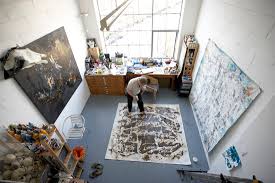
In ‘The Sacred’ Elizabeth Oldfield of the Theos Think Tank talks to various people about the sacred. In one, John Lloyd (the TV producer best known for comedy programmes such as Not the Nine O’Clock News, Spitting Image, The Hitchhiker’s Guide to the Galaxy, Blackadder and QI) talks about paradox.
Lloyd has a theory that Picasso, for all his fame and success as an artist – as well as the wealth, the mistresses the lifestyle to go with it – left that all behind him when he went into the studio. He needed the openness, the patience and the courage to fully engage with his art. Lloyd felt confirmed in this view when, later, he came across this quote from Picasso: “When I enter the studio, I leave my ego at the door the way the Moslems leave their shoes when they enter the mosque, and I only allow my spirit to go in there and paint.”
Perhaps the same is true of most, if not all, great artists, composers, writers and social reformers. That they are at their most creative, their most individual, when they are away from the centre of the ego, and engaging with the margins with a humility and an openness that will lead them along paths of uncertainty that allow the spirit to lead them in often new and unexpected ways.
The paradox of the margins is, I believe, that the more that we are in the margins, the closer we are to the centre. Perhaps, as Lloyd suggests, the etymology of the word ‘sacred’ is relevant here: it comes from the Latin sacer, meaning both sacred and accursed: a paradox if there ever was one.
10. The Shadow

The psychologist Carl Jung took great interest in those parts of ourselves which we struggle to accept and therefore, often unconsciously, push into the margins, or shadow.
Jung could feel anxious and afraid and guilty without being ashamed of feeling this way. He understood that an integrated person is not a person who has simply eliminated the sense of guilt or the sense of anxiety from his life – who is fearless and wooden and kind of sage of stone. He is a person who feels all these things, but has no recriminations against himself for feeling them.
He knew his shadow so strongly, and so clearly, and, in a way, so lovingly, that he would not condemn the same thing in others. As a result, he would not be led into those thoughts feeling and acts of violence towards others which are often characteristic of people who project the devil in themselves onto the outside, onto somebody else, onto the scapegoat.
This is what Jung may have had in mind when he wrote to a Christian friend as follows:
“I admire you Christians, because when you see somebody hungry or thirsty you see Jesus. When you see someone in prison or hospital you see Jesus. When you see somebody who is strange, a stranger or naked you see Jesus. What I don’t understand is that you don’t see Jesus in your own brokenness. Why are the poor always outside of you? Can’t you see they’re inside of you: in your hunger and thirst? That you too are sick: that you too are imprisoned in your own fears or need for honour and power; that you too have strange things inside of you which you don’t understand; that you too are naked?”
(Based on a talk by Alan Watts on Karl Jung; Quote on Christians from ‘Disability in the Christian Tradition: A Reader, Edited by Brian Brock & John Swinton).
